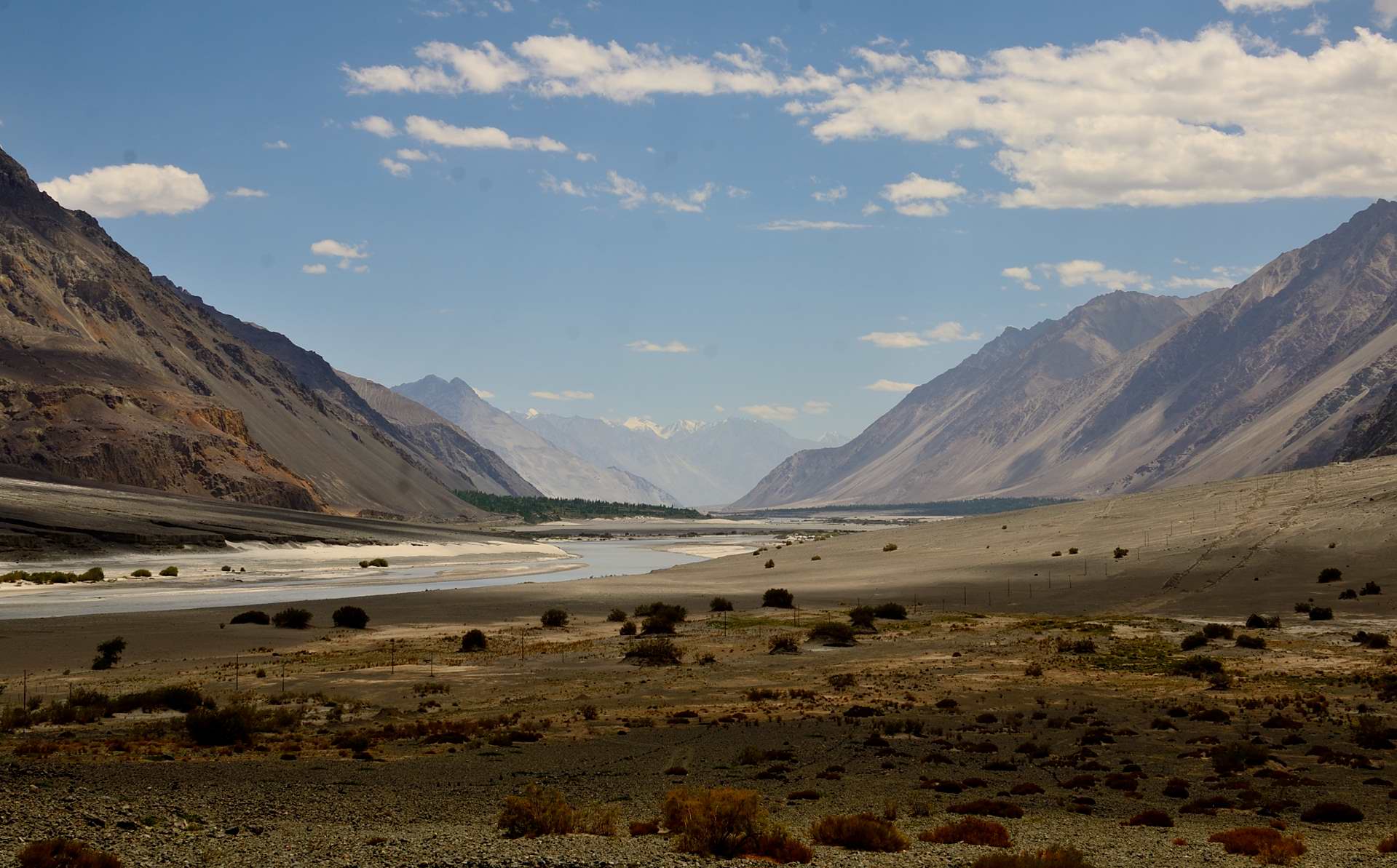
It was day nine of our road trip to Ladakh. It was a dream which culminated in driving all the way from Dhanbad in Jharkhand to Leh and beyond by road. This dream trip was happening after several postponements of the original plan and after overcoming many niggles that were beyond our hands. But this is not about the road trip but about a place that was out of bounds for general travelers even a few years back. Turtuk as the place is called probably the northernmost place beyond Nubra Valley where civilians are permitted to go. We were already in the famous Nubra Valley the day before. The day’s plan was to visit Turtuk and explore it. This region was captured by the Indian Army like many others during the 1971 war with Pakistan. The only difference is that this place was never returned to them after negotiations! Permission for civilians to visit the Turtuk region was first opened in the year 2010 and some of the other villages in the region much later.
 The Shyok River crisscrossing the valley near Turtuk
The Shyok River crisscrossing the valley near Turtuk
So as per plan, we started from Hunder in Nubra Valley to Turtuk after breakfast. We started late as the distance to Turtuk is around 68 KMs one way. Those who visited Ladakh can tell that it’s mostly consisting of barren mountains, mostly devoid of vegetation. Little did we know that we were about to undertake probably the most beautiful part of our journey so far. Just as we drove out of Hunder the vast expanses of beautiful Shyok valley unfolded before our eyes. The landscape was refreshingly green! A welcome change after many days of driving through almost barren mountains! A black road that resembled a snake that crisscrosses the valley, the blue sky with scattered fluffy clouds, boulders of different shades on the roadside, the river Shyok which was giving us company throughout at times separated by just a row of boulders, partially snowcapped mountains with tiny villages situated mostly at points where some glacial stream is descending from these mountains was just adding to the whole experience. The whole setup was dreamy and it would not be an overstatement if I say we were traveling through heaven! No prizes for guessing that we took our own sweet time to reach the day’s destination.
Our destination for the day was Tyakashi village situated very close to the Line of Control (border) with Pakistan. As we reached the last check post we were pleasantly surprised that the routes to another village called Thang which is even closer to the border were now open for civilian travelers. We were more than happy. Although the distance from check post to Thang village was 7 KMs it was only an extension of the beautiful roads we traveled so far that day. The only difference now was the valley which became a little narrower, the mountains came closer and the river Shyok was flowing deeper through the valley. As we neared Thang a signboard reading “You are under enemy observation” suddenly made us aware that we were actually traveling very close to the Line of Control with Pakistan.
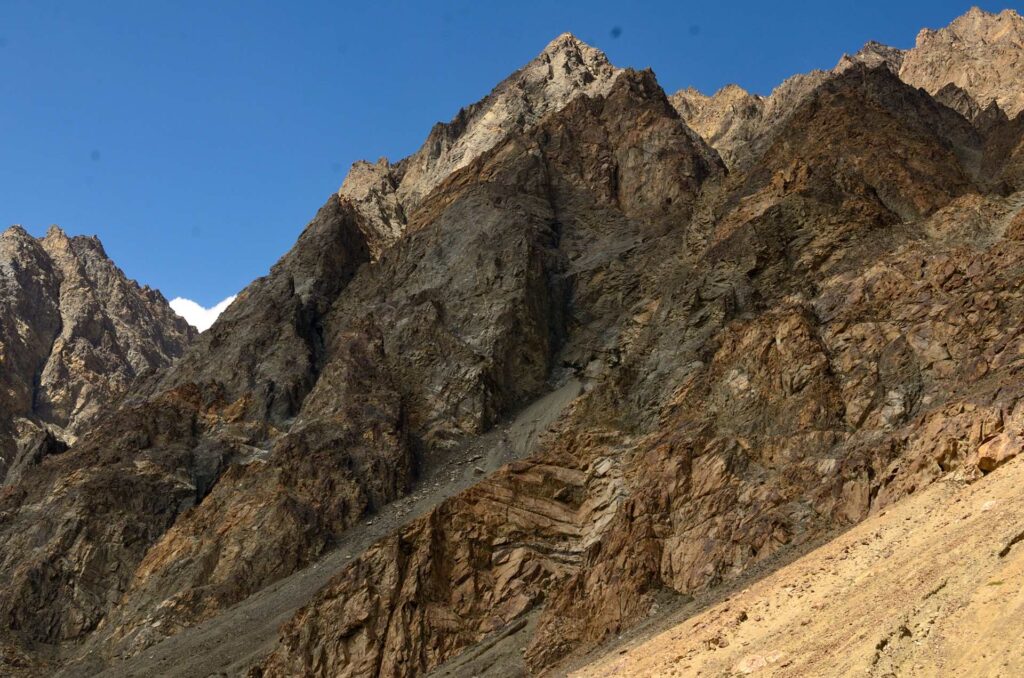 High mountains near Thang,Turtuk.
High mountains near Thang,Turtuk.
The feeling of traveling so close to the border was a mix of caution which was obvious and of happiness. I still could not tell which of these feelings were prominent at that time! Have you ever felt what it’s like to be an Indian? Well, maybe I am coining the question in the wrong way. Of course, those who are born in India are Indians but the consciousness of being an Indian mostly comes when we win some big sporting event (it’s cricket most of the time!) or when we visit some other country or when we visit one of these places like Thang. The feeling was totally different for us and I think it could not be described properly, it has to be felt!
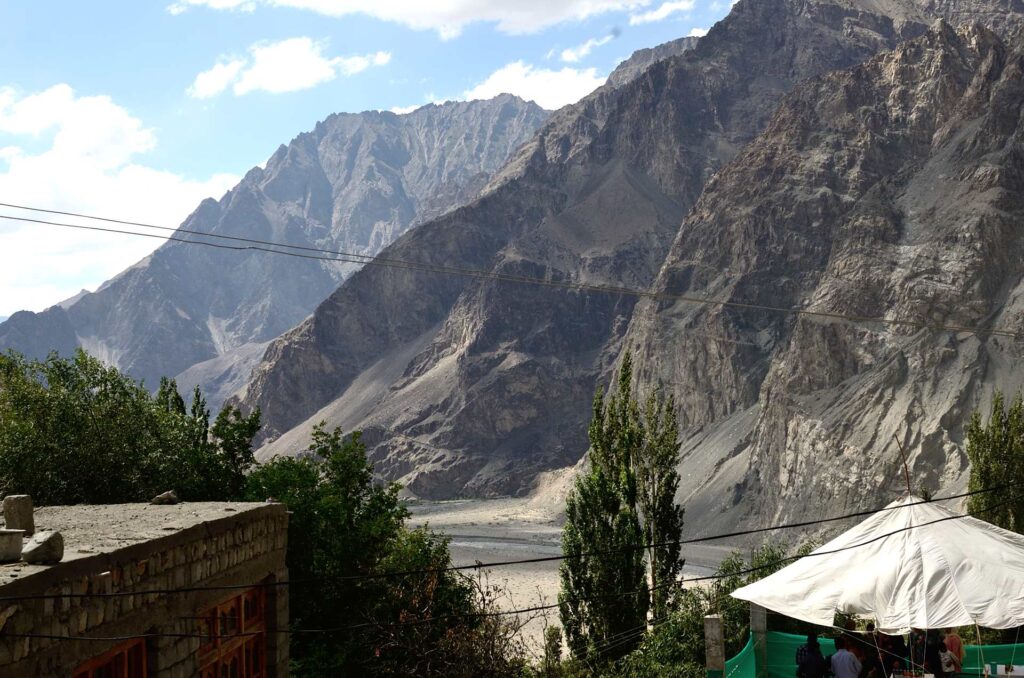 A local caffe overlooking the distant LOC, at Thang, Turtuk
A local caffe overlooking the distant LOC, at Thang, Turtuk
Once at Thang, we were welcomed by a few kids who volunteered us to show the village. Well, the village is just a settlement of a dozen or so houses. As per the 2011 census, the village had a total population of 103! The border is so close that one could literally spot Pakistani Army bunkers using binoculars or a good zoom lens. A few local cafes selling tea, coffee, Maggie, bread-omelet etc use this proximity of LoC by offering travelers with good binoculars and using it as their USP. The journey was made sweeter by the presence of a large number of apricot trees and that too laden with ripe apricots. It is said that the sweetest of apricots are found in Turtuk and how could we miss this opportunity when we were there in season. Well, we had our fair share of apricots at Thang.
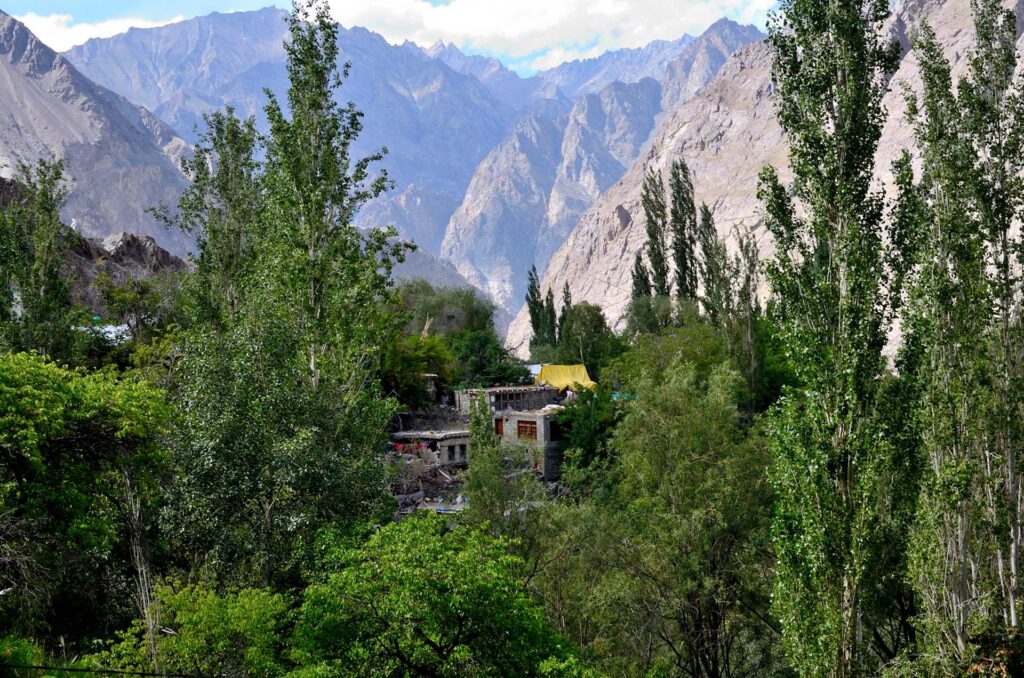 The hidden Tyakashi village in Turtuk
The hidden Tyakashi village in Turtuk
The next destination for the day was Tyakashi, the place that was in our mind when we started the day’s journey. It was a narrow plateau, almost hidden by mountains from all sides situated above the main road that connects Turtuk to the Nubra valley. Vehicles had to negotiate steep curves to reach the tiny parking place on the hillside which may hold a maximum of 10 cars at a time. We got a tiny space just enough to park our car on an incline and placed stones near the tyres to prevent it from any accidental rolling down! The village was further up and could only be reached by walk. It was a big task considering rarefied air where taking every step was a challenge in itself. But once we started the walk we were mesmerized by the views this little village had to offer. Our main aim was to visit a tiny village school that was built by the Pakistani government and was operated and expanded by India for a long time after its capture by India during the 1971 war. The walk was about 2.5 KMs from the parking lot but it was a tough walk even though ascends and descends were gradual after the initial few meters.
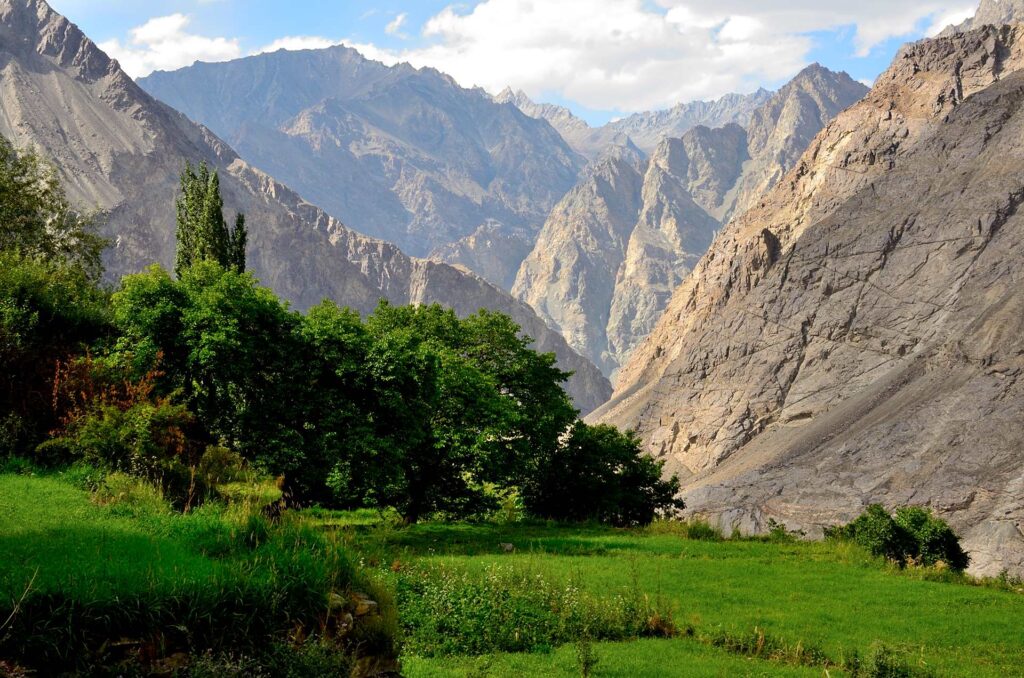 Orchards and farms at Tyakashi village, Turtuk.
Orchards and farms at Tyakashi village, Turtuk.
The Tyakashi village turned out to be surprisingly green even at these heights. The village is covered with many orchards and small farms, a wonder considering almost naked mountains it was surrounded by. The reason could be the glacial stream that was flowing through the village. During this whole walk through the village, our constant companion was this superfast glacial stream which was channelized by villagers for their daily needs. Villagers were also welcoming with their lovely smiles.
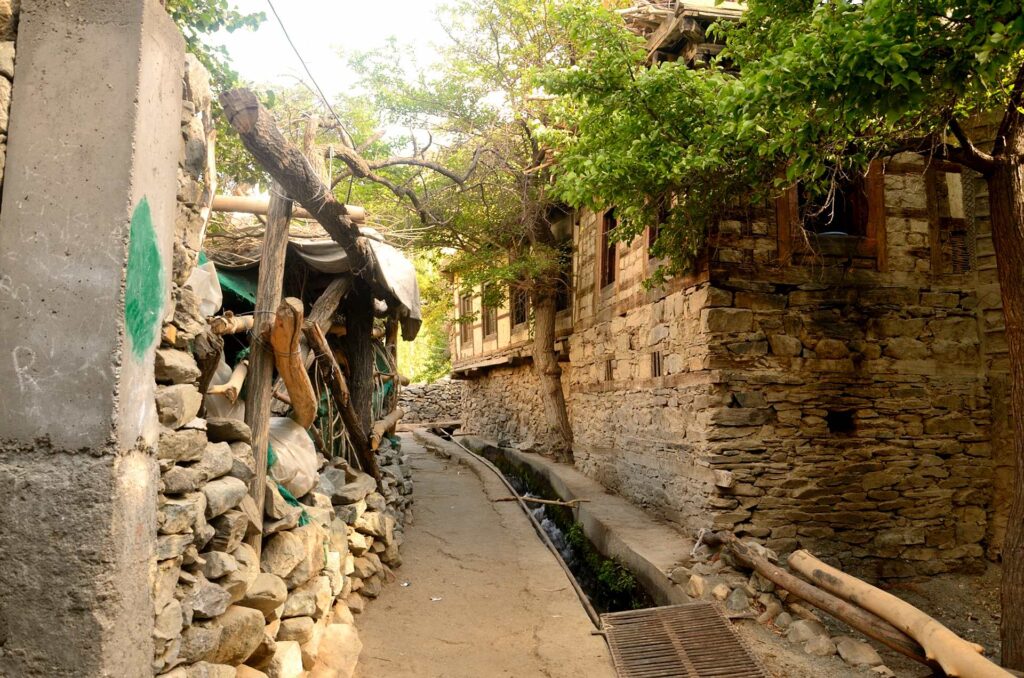 The narrow alleys of Tyakashi village, Turtuk.
The narrow alleys of Tyakashi village, Turtuk.
And the school that we intended to visit was lying at the end of the village! So after this straight but tough walk covering almost the whole village, we finally reached the school and it was empty. Ok, no surprise here as the sun was about to set shortly. Classrooms were open and were full of graffiti, massages by lovers- kind of what one could witness at many public places throughout the country. Seeing the condition of the classrooms it can be said that the school had seen better days. The best part however was the views from the windows of these classrooms. They present a magnificent bird’s eye view of distant Thang village, the Shyok river valley which looks tiny from that altitude and of course the Line of control. The Border view cafe near the school was just perfect to take some rest, have some refreshments before taking the return journey. After spending some time at the café we started our return journey, fully content in the company of cool breeze, soft evening sun and of course the gurgling glacial stream.
******
How to reach: Turtuk is around 68 KMs from Hunder in Nubra Valley and 103 KMs from Leh city. It can be accessed only by road. The nearest airport is Leh which is well connected to most major airports in the country. Ladakh is yet to receive a railway connection. The nearest major railhead is at Jammu (675 Kms), Chandigarh (735 Kms).
Where to stay: Turtuk has a few small homestays and guest houses. Most tourists visit there in the daytime and return to Hunder or Diskit in Nubra valley by evening which has many options for comfortable stays suiting all budgets.
Food- Most homestays and guest houses in Turtuk and Nubra valley provide in-house dining, especially breakfast and dinner as options outside are very limited, especially during early morning and night.
Precautions- These are high altitude, above the tree line Mountains. The atmosphere is rarefied hence it takes some time to acclimatize. Give yourself time to acclimatize properly. Don’t rush to anything. Apply a good suns cream lotion to prevent heavy tanning. Drink water frequently; take small sips even if you are not thirsty. Acute Mountain Sickness is a reality in these areas so take proper precautions. Remember, these are pristine mountain areas of the country hence please do not litter, create minimum waste and dispose of it properly, minimize the use of plastic.
Share this post: on Twitter on Facebook
Please visit:
Our Sponsor
